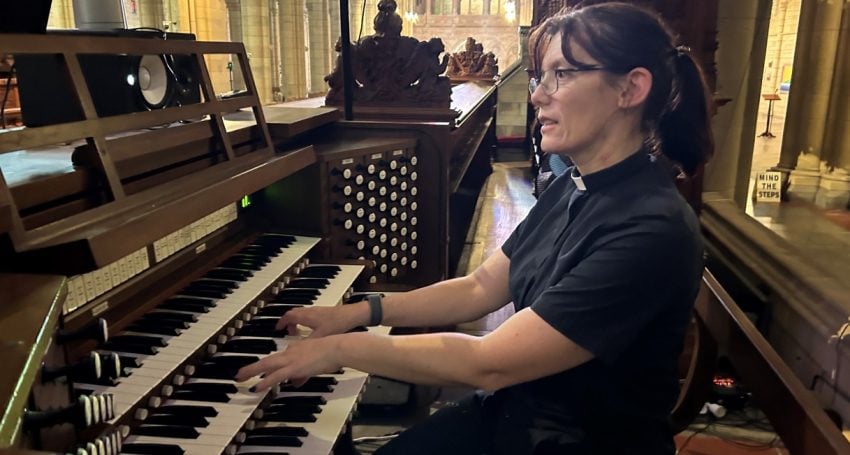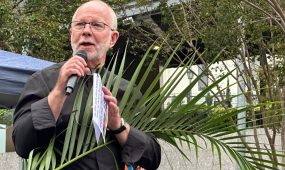My liturgical organist journey
Reflections
“It would be remiss of me not to mention how the organist actually has a certain amount of opportunity to express a sense of humour. Examples of this include the time when I heard an improvisation unmistakably including the theme tune to Wallace and Gromit or when the postlude for the Feast of the Assumption was ‘Hooray and up she rises’,” says The Rev’d Dr Gemma Dashwood OAM

I sometimes get asked what the difference is between a concert organist and a liturgical organist. My suggested response is something like:
“A concert organist worships playing while a liturgical organist plays to worship”
There are, of course, those clever people who can be both, but for me, my journey to being a liturgical organist probably began when I started playing the pipe organ in our little school chapel. It is a passion that has continued to develop through my time as assistant organist and eventual music director at All Saints’, Ainslie in Canberra, and still grows in my current life as a priest. Probably the greatest joy I find in being a liturgical organist comes from being able to interact with the congregation by attempting to reflect the emotions of the liturgical year and (hopefully) enhancing their worship.
My liturgical appreciation has certainly developed over the decades — and my approach to playing in church has without doubt altered considerably. While I was always aware of the liturgical requirements of a church organist, it probably wasn’t until I started my theology degree and formation training that I found my focus shifting somewhat.
The most obvious change I noticed in my playing was that I approached it less as a “performance” and more as part of my personal worship. Particularly striking was how I started to understand how relatively unimportant the postlude was. I remember as a younger student spending hours a week on finding and perfecting something to play for the end of the service, sincerely believing that the most complicated, difficult and fancy thing I could find would be the best thing to play. In fact, some of the most powerful musical moments have been when I have played the simplest things (such as when I played a very quiet “Abide with me” at the end of the service as we closed the church for COVID lockdown) or indeed the occasions when the organ has remained silent.
Rather than spending my time learning postludes, I started to look deeper at the various parts of the service instead. Playing hymns, for example, is not just about getting the notes right (although that helps, of course!) but also using the different sounds of the organ to reflect the words of each verse — helping the congregation to undertake the journey on which the hymns is leading them. Organs have a wonderful flexibility about them — so there is every opportunity to reflect “earthquake, wind and fire” one moment and “a still small voice of calm” the next.
Advertisement
I also really started considering how I could play the Mass setting in a way that reflected the theology behind what was being sung. For example, I started having discussions with other organists about whether they made “Amen” loud or soft (hint: there’s no “right” answer!). Once I started taking more notice, I realised that the penitence reflected in the “Kyrie” could be powerfully contrasted by the joy of the “Gloria” and the subtly of the “Angus Dei” had the potential to prepare the congregation to approach the altar.
I also discovered that for me personal worship is very different (but no less powerful) when taking part in the liturgy from the position on the organ stool. As a liturgical organist it is necessary to concentrate hard to ensure that the correct music is ready to be played at the correct time, that the organ is set up for the next item to be played and if necessary decide how long an improvisation needs to be extended for various processions. This all takes a lot of effort, and it is not realistic to enter into such a deep reflective space as it is when sitting in the congregation. Nevertheless, I still find that I can feel the sense of worship and fulfillment even it isn’t in the same way.
Advertisement
Finally, it would be remiss of me not to mention how the organist actually has a certain amount of opportunity to express a sense of humour. Examples of this include the time when I heard an improvisation unmistakably including the theme tune to Wallace and Gromit or when the postlude for the Feast of the Assumption was “Hooray and up she rises”. In my role as clergy, I know only too well that it is not worth upsetting the organist — for no other reason, the trumpet stop on the organ is louder than any noise I can make!
All jokes aside, being a liturgical organist is a tremendous privilege, and I hope that it is a skill that I can continue to develop throughout my life. Moreover, I hope that the interest, excitement and passion in liturgical organ playing is something that can continue through many more generations to come.
First published in The Eagle, the magazine of St John’s Cathedral. Download your copy today.





